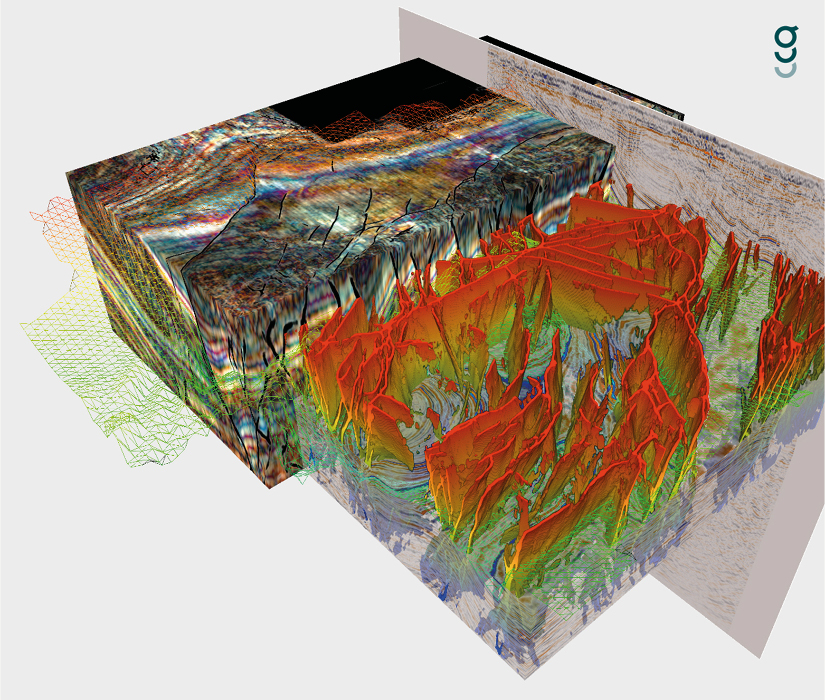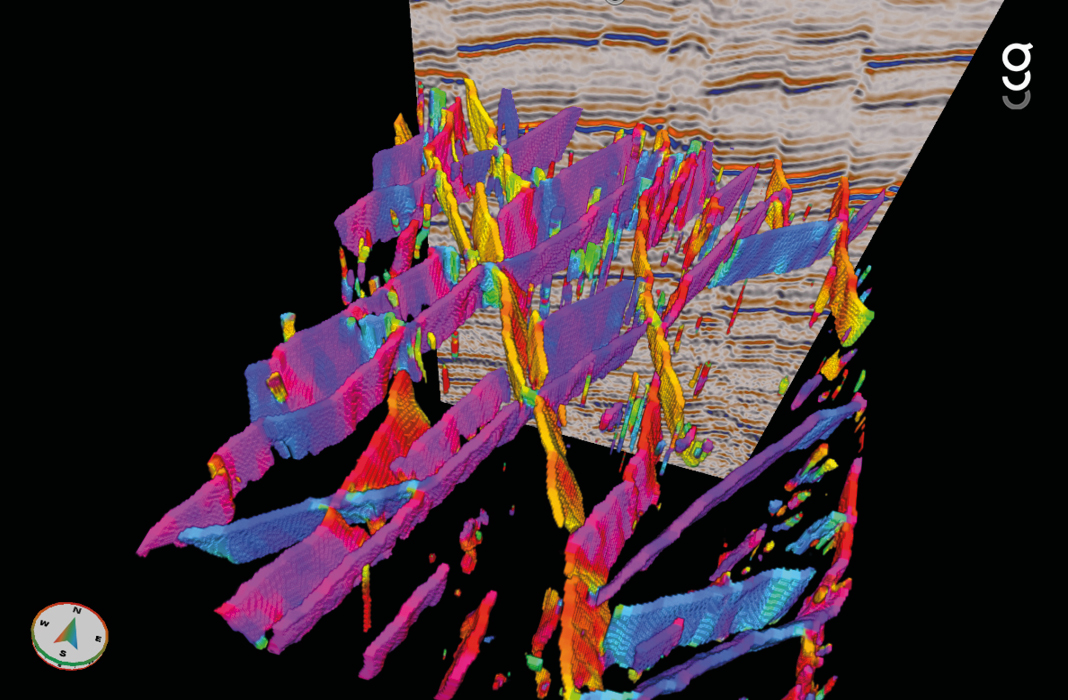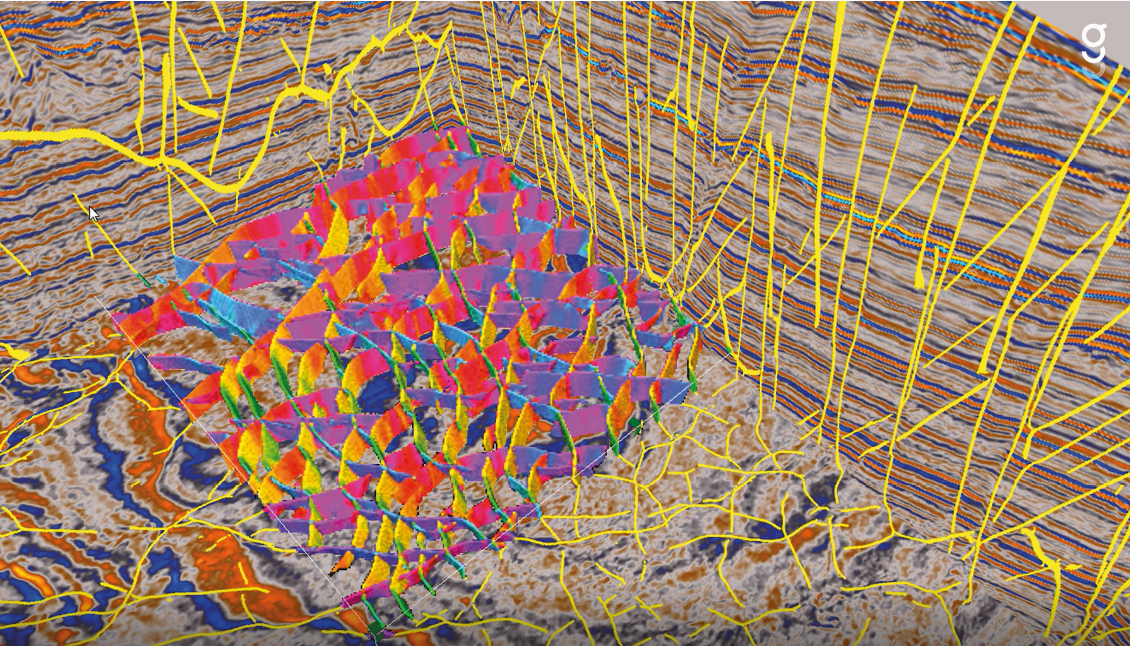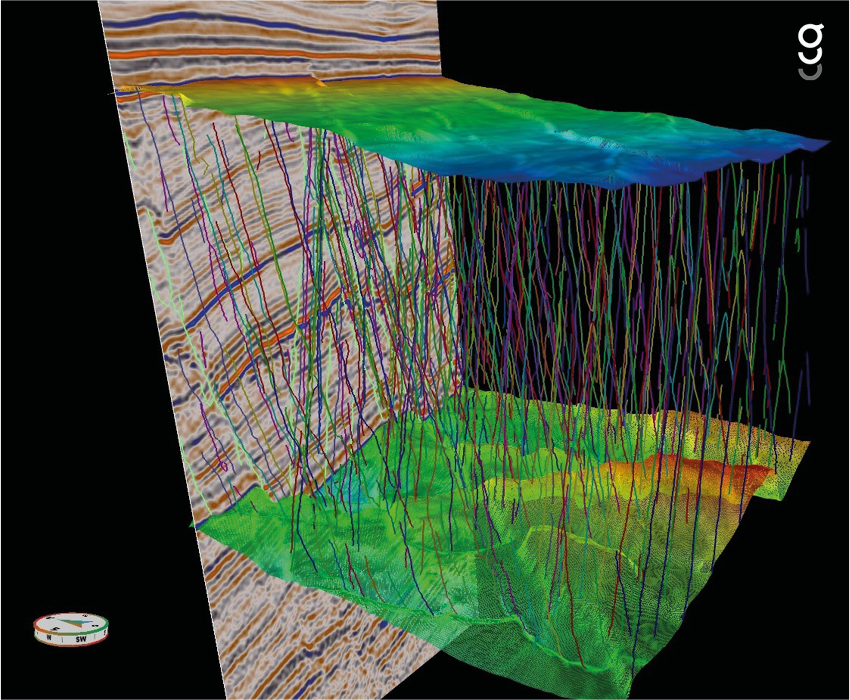It is the biggest technology revolution we have seen; you have probably heard “AI is the future” – but what can it do to improve the decision making process for geoscientists in oil and gas exploration?
Developed by geoscientists and software developers, Geoteric’s AI Seismic Interpretation is fully integrated within the workflow. Steered by three core elements in our mission statement – science, people and technology, Geoteric designed an AI-driven Seismic Interpretation platform with the interpreter in control. With people at the heart of the design, it combines the strengths of human knowledge plus the capability of the machine.
Subtle details and trends can be challenging to interpret manually. Added to that, varying data quality can be an issue all too real in subsurface understanding. Machine Learning’s ability to learn and improve over time means that poor data can be analysed with far greater accuracy than is often possible to see as a human interpreter; for example, data degraded by the presence of a gas cloud as illustrated in our AkerBP case study.
Geoteric’s AI platform is capable of working with a range of data qualities; new high-quality data works well, but so does readily available off-the-shelf data, as shown by our case study work on publicly available release data sets. With ever-increasing volumes of data being analysed, including old data, inevitably some will be of poor quality. Geoteric’s tolerance for imperfect data provides an advantage, especially when working with older data sets and is illustrated in our GoM case study.
Results can be incorporated and optimised in Geoteric’s standard software to add in greater clarity of detail and increase confidence levels when used in combination with traditional lines of geophysical imaging, such as spectral decomposition. This allows interpreters to combine their knowledge with the best possible results, in a workflow enabling informed decisions to be made much faster throughout exploration, development and production.
Added to that, interpreters are susceptible to unconscious bias. This has significant implications on interpretation results and is often driven by lack of time, poor image quality, and the most recent projects worked. To avoid the dangers of anchoring or simplified views of complex systems, the initial unbiassed AI assessment of the structural framework provides a detailed answer. It also provides a great catalyst to discuss, without significant interpreter bias or reputational investment, encouraging a fast, open and comprehensive assessment of the structure.
Reach New Levels of Understanding as Your Hydrocarbon Fields Reveal Their Secrets
Geoteric recently announced the launch of its two new revolutionary seismic interpretation products, powered by artificial intelligence (AI): Collaborative AI and Geoteric Stratum™. So you can now enhance your knowledge of the Earth, and increase the speed and accuracy of your interpretation in a way that suits you – without the need for specialist training. Readily incorporated into existing or new workflows at any level, see how our cutting-edge AI technology is enabling a revolution in subsurface understanding.
“Our AI interpretation solutions allow users to achieve the industry-leading results they expect from Geoteric. We have combined over 30 years of geological experience with an in-depth knowledge of AI to create customised networks that generate high fidelity results” said Nicola Blanshard, CEO of Geoteric.
“This leading-edge AI technology has been offered exclusively through consultancy projects during the past 12 months. The feedback we have received has been very positive; clearly, this technology provides our clients with substantial new insights into their assets.”
She added, “I’m incredibly proud of our team’s passion, drive and commitment, which has resulted in the delivery of our ground-breaking new AI seismic interpretation products.”
Collaborative AI in Geoteric
Our new Collaborative AI software complements the existing Geoteric workflows. You can improve your traditional interpretation, and efficiently extract faults from seismic data at the click of a button – no requirement for network training unless you want to.
Traditional line by line interpretation is time-intensive and only interprets a fraction of the dataset. By moving from line by line analysis to Collaborative AI, the interpretation is augmented with artificial intelligence, which enables faster and more accurate results.
“The quick turnaround enabled Ithaca Energy to absorb the detailed information and utilise additional studies to understand the complex geological history.” – Ithaca Energy
Geoteric Stratum™
Geoteric Stratum is our new cloud-based AI software that delivers simple usability and even greater detail for fault identification, reservoir compartmentalisation and well trajectory planning. By adding an extra dimension of analysis, Geoteric Stratum achieves outstanding results with an intuitive workflow and gives you the critical information that will inform exploration and development decisions.
Our new SaaS [Software as a Servic] offering does all the work for you so you can focus on the final story; the risks, the upsides and the economics of your field. Discover new structural and stratigraphic features, which were never visible before by analysing all of your data with results in seconds. Go beyond interpretation and produce your most advanced understanding of the subsurface.
“Geoteric’s AI-Fault interpretation had an immediate impact on our subsurface understanding, enabling an improvement to our well planning process” – Wellesley Petroleum
How Does Geoteric AI Apply to the Seismic Interpretation Workflow?
Geoteric’s AI interpretation tools have been designed to build a level of trust and confidence across three steps which are fully integrated into the users’ workflow;
- Regional focus
- Reservoir focus
- Pre and post drilling well focus
Much like the traditional workflow, which requires the application of different methods to develop a rich understanding, the same concept applies to this offering. Designed to improve understanding and learning at each decision point, knowledge can be effectively built throughout the workflow. It is formed in such a way that results are easily integrated into the traditional workflow today for complete quality control at each step.
The first step of an integrated AI interpreter workflow is evaluating the accuracy of the regional focus result on any slice within the seismic cube in real-time. Therefore, there is an opportunity to calibrate results, to ensure that users do not solely have to rely on the ‘out of the box’ results. This means customers may want to develop and train their interpretation, capturing the detail of their data in their unique network.
Networks can then be applied across different datasets, transferred between regions, basins and epochs for company-specific enhanced networks to help deliver more accurate results. Multiple networks can be used to develop a more efficient and impactful understanding whilst building confidence to ensure care is taken to avoid misinformation and unintended bias which could hinder as opposed to enhance the process.
Geoteric’s AI platform has been designed so fault sticks can be automatically extracted or grouped (depending upon the business need) to allow further user edits. As projects start to focus on regions of enhanced interest, these edits will be used to feed into the reservoir and well focus steps if required.
Results from the network not only improve; those improvements can be applied to future datasets. Augmenting human interaction, you can ensure AI is safe, fair and explainable, resulting in geoscientists being able to explore vast amounts of seismic data, gain confidence in the AI output to derive insights and test their assumptions to build a greater understanding of the Earth.
“Our most comprehensive fault interpretations to date. This has improved the rigour of our work so that our decisions are based on a better understanding of where faults may introduce drilling risks, and so that we can better understand lateral changes in our reservoir” – Aker BP
What Are the Implications for Your People, Your Business and the Energy Industry as a Whole?
Forget human versus machine, Geoteric’s AI Seismic Interpretation platform presents us with an opportunity to do more, learn more and flourish in ways we can’t yet even imagine.
Upstream companies still need to do more to thrive and control their costs to ensure they continue to take investments forward, grow and commercialise them. Operators continue to look to understand what is the opportunity that AI presents to their workflow and to recognise the impact it can have on their results, their processes and their people.
As we operate in a time of transformational change, expectations are higher and far-reaching across the natural, political and social environments. In an uncertain price environment, businesses look towards what they can control, staying resilient whilst strengthening their long-term sustainability. These challenges and expectations reaffirm the need for our industry to reinvent. Not just to keep costs low today whilst maintaining health, safety and environment (HSE) standards, but to continue to reduce risk, protect their people and the environment, all whilst unlocking new resources and producing more affordable energy with minimum investment.
There is certainly no doubt any business with large amounts of data can use AI to replace those monotonous, repetitive tasks to enable cost reduction in the short term. However, a process easily automated only scratches the surface of AI potential. By nature, AI offers a radical new reality. Designed to be helpful, the ultimate purpose for AI adoption in the seismic workflow is to provide a greater understanding of the Earth.
If you think of AI as a replacement to your current workflow, your focus is misguided. AI is not just about generating new levels of efficiencies; its real power is opening new ways of working and generating value beyond what was expected. This means processes should not merely be replicated; instead, they should be re-imagined and re-engineered to utilise AI to its fullest potential.
One truth remains: no tool will fully replace the art of interpretation. The best integrated AI seismic solutions harness the knowledge, present the opportunity to learn more, do more, providing support when users need it most. In this way, interpreters can add more value to the business by a more thorough understanding, drive operator growth in new ways through new levels of decision making and more confidently outline the difference between a good and bad prospect.
The Future of AI in Subsurface Understanding
Over the past century, technology has helped us gain a better understanding of our world. We believe a thorough understanding of the Earth can shape new perspectives and provide solutions to some of the greatest challenges we face today, which is why we’ve spent over 30 years expanding what’s possible in geological analysis.
As we journey down from the surface, we want to help geoscientists unleash the potential of their data to gain a deeper understanding. So, no matter what you’re looking to achieve, be it powering the industries of today, to protecting the world of tomorrow. Anything is possible when you can see beyond the surface with Geoteric.
Further Reading from Geoteric
Advancing Subsurface Understanding and Maximising Operational Efficiency with AI
Mark Brownless, Chief Geoscientist, Geoteric
Subsurface interpretation using AI is here and being used on live projects. It is delivering clear improvements in subsurface understanding at a time when it has never been more important to make the correct decision to drill or to drop.
This article appeared in May, 2020
Reducing Drilling Risk with AI Fault Interpretation
GEO ExPro
Geoteric’s AI Fault Interpretation enhances operational efficiency by identifying potential drilling risks in recent project with AkerBP.
This article appeared in Vol. 17, No. 3 – 2020
Trusting AI in the Subsurface
GEO ExPro
Before widescale adoption of artificial intelligence across the subsurface arena, there is still one outstanding question; can it be trusted?
This article appeared in April, 2020
Artificial Intelligence and Seismic Interpretation
James Lowell, Peter Szafian and Nicola Tessen; Geoteric
The key to all seismic interpretation is the interpreter’s experience and knowledge, so why should artificial intelligence change that? The reality is, it shouldn’t.
This article appeared in Vol. 16, No. 2 – 2019









